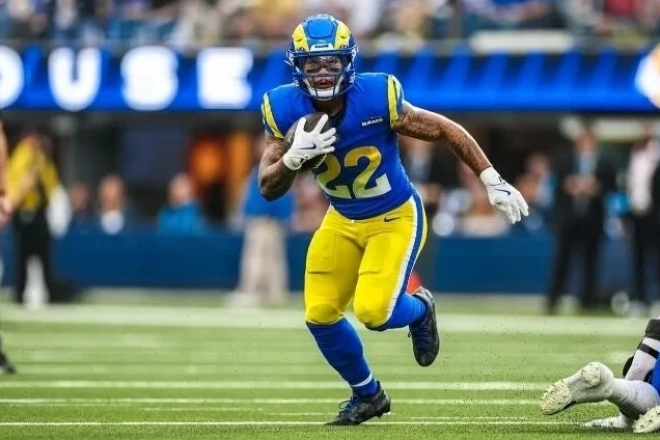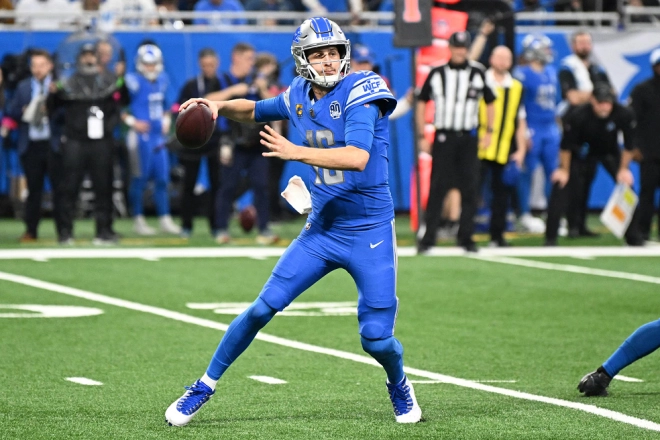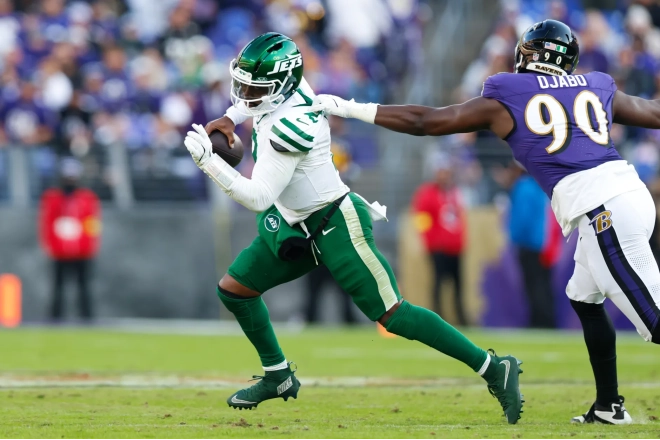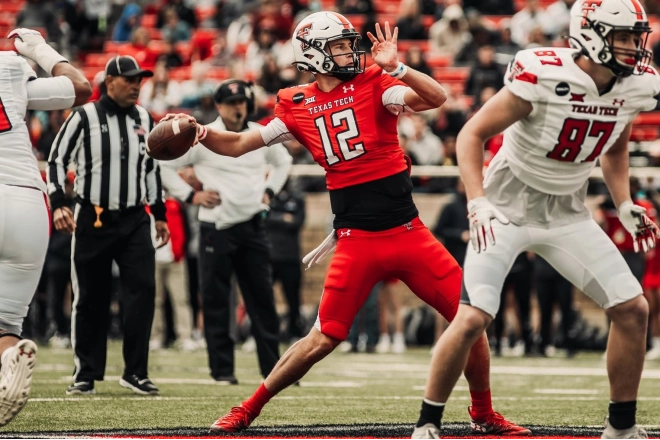Full Series: QB RB WR TE Conclusion: My 2025 Strategy Result of 2024
Introduction
Ahead of my dynasty draft, I want to learn the relationship between average draft position (ADP) in rookie drafts and the long term success of the player. I update this study each year to see what I can learn. This is my study from last year: How To Add A QB1 To Your Dynasty Team - '24.
It was because of this study that I picked up Bo Nix (Den) in our 2024 dynasty rookie draft with my 3.04 pick, adding a second QB1 to my roster behind Jalen Hurts (Phi) whose Week 16 1st quarter injury eliminated my team from its sixth-in-a-row playoff run.
The Importance of having a Top-6 QB
I consider having a top-6 QB the most important priority for my dynasty team. QB is the highest scoring position and there is a significant fantasy point drop off from the 1st to the 12th QB in any season. Anything less than a top-6 QB as a starter is an anchor for a fantasy team. A bottom QB1 is good as a backup for bye-weeks and injuries.
Before doing these yearly studies, I used to believe I could lock down a Tom-Brady-or-Peyton-Manning-esque QB for a decade as the cornerstone of my dynasty team.
However, statistical analysis shows a different reality. Only two QBs that entered the league in the last ten years have been a top-6 QB for fantasy three or more years in a row, Patrick Mahomes (KCC) and Josh Allen (Buf). This could be because in today's NFL, top-6 QBs for fantasy increasingly are dual-threat QBs, increasing injuries and reducing longevity to about that of a running back. I described the reality of the high QB injury rate in my article, Quarterback Carousel & Handcuffs, which is about managing for a QB injury.
The bottom line is that the top-6 QBs for fantasy are more fluid than in the days of Tom Brady and Peyton Manning, and therefore a fantasy manager must be pro-active to continue to add QB talent to his roster every year.
Going into the 2025 season with Hurts, Nix and Anthony Richardson (Ind). Hurts is probably fine for 2025 and Nix is a solid back. However, Hurts is likely near or past his peak, and it isn't clear that Nix will ever be a top-6 QB. I can probably forget about Richardson. I think there is a reasonable chance he will win the competition against Daniel Jones. However, even if he does win that competition, only two QBs that entered the league in the last ten years that were not a QB1 in either of their first two years became a QB1 in their third year, Tau Tagovailoa (Mia) and Derek Carr (NO), and they were bottom-6.
So, now I am trying to trade Richardson for a 2nd round pick, and I certainly would like to add another QB that has the potential to rise to be a QB1 by the end of 2025 or 2026 season to maintain my team's QB room advantage.
Evaluation Method
This year, based on my strategy for stock piling draft picks, I have the 1.02, 1.09, 2.02, 3.02, 3.03, 3.09, 3.11 and 3.12 pick in my draft. I have my favorite sources for player evaluations and that enters into my draft plan, but first-and-foremost I am a numbers and math guy. I want to crack the code without needing to be or to rely on an expert NFL analyst.
So the motivation behind this study is to find the success rate of drafting QBs versus average draft position (ADP). And whether you are desperate for a QB or, like me, just trying to maintain a solid QB room in a fluid NFL environment, I believe this study can help you use your draft picks efficiently for building your QB position.
Historical ADP Information
Based on historical ADP information, this is where quarterbacks were drafted since 2014:
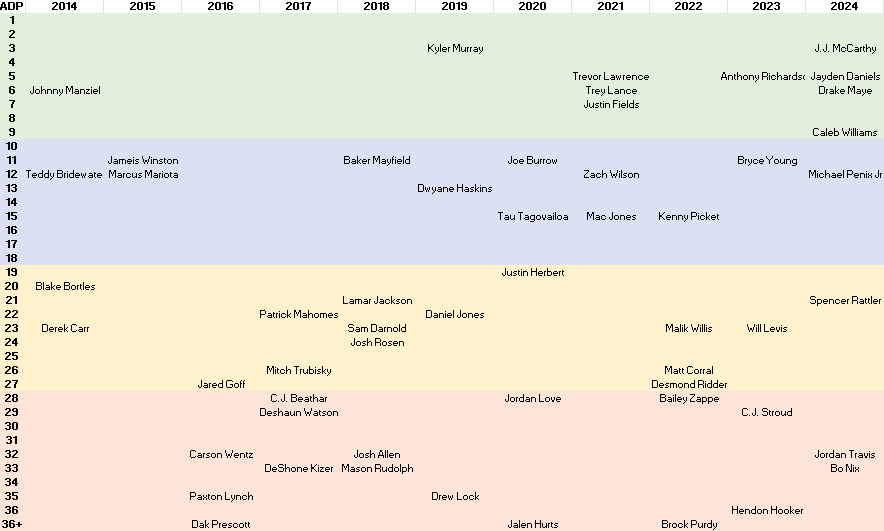
Drafted no earlier than the bottom of the 2nd round, Mahomes, Allen, Dak Prescott (Dal) and Hurts are the steals of the last decade. Now the question is which QBs will be the steals of this decade?
Success Rate vs Years of Experience
Now, going back ten years, I look at how these QBs panned out for fantasy purposes. For each year a QB was a top-6 QB I give him1 point, and for each year a QB was a top-7 to top-12 QB I give him 0.5 points. I then take the integral of all their results, which produces this chart:
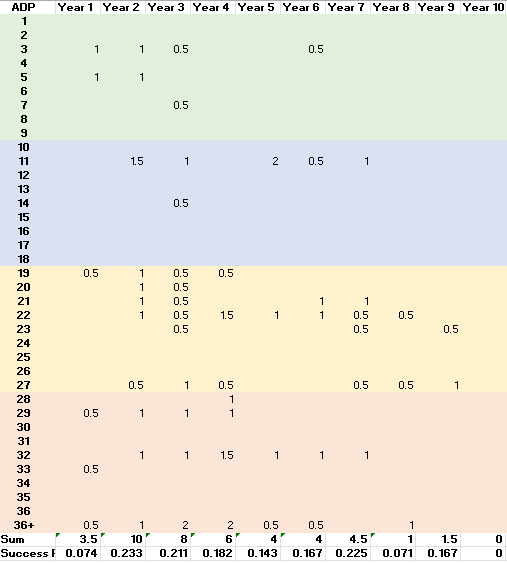
The last row shows success rate versus years of experiences.
Below I show these final numbers as graph:
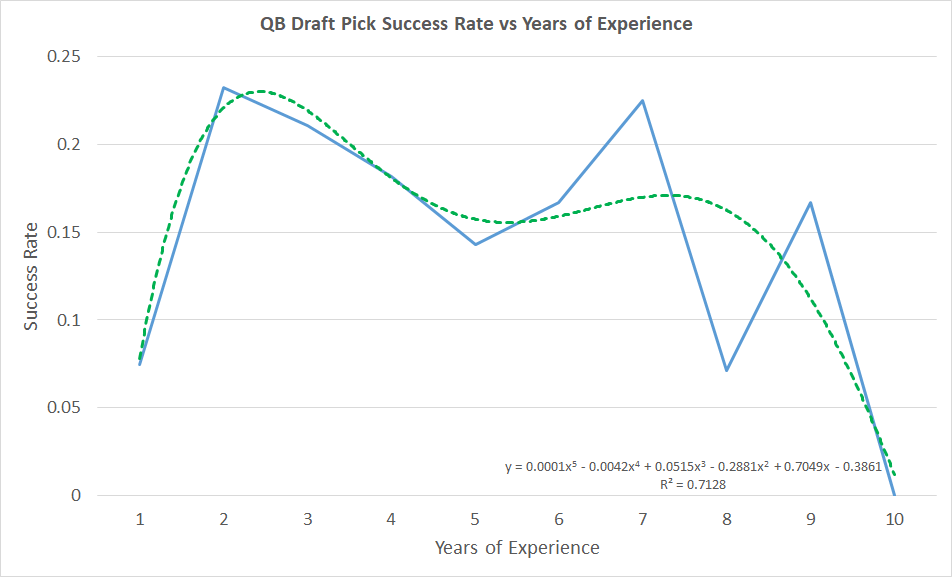
Quarterbacks are rarely a QB1 their first year. However, those that will become QB1s usually do so by their sophomore year and then level off. Then they start to drop off from year 8 to year 10.
2025 might be the beginning of a lot of QB1 turnover. Lamar Jackson (Bal), Allen, Baker Mayfield (TB) and Sam Darnold (Sea) are each entering their 8th year, Mahomes, his 9th, and Jared Goff (Det), his 10th.
In addition to longevity of QB success, now I break down QB success rate by ADP round:
1st round: 14.2%
2nd round: 18.9%
3rd round: 15.6%
Also because of what I was seeing, I broke the success vs ADP data into 4 bands of 9 draft positions each - which is the reason for the four bands of color in my first two charts. This is the success rate by those four bands of ADP range:
1.01-1.09: 16.7%
1.10-2.06: 9.8%
2.07-3.03: 21.8%
3.05-3.12: 15.1%
How is it possible that the results are almost the reverse of expectation. Last year fit the pattern again. Jayden Daniels (Wsh) was the only QB1 out of the five QBs with an ADP in the first round. Only one QB had an ADP in the 2nd round, and he was not a QB1. Nix also was the only QB1 out of two QBs with and ADP in the 3rd round.
There is a long history of successful lower pick QBs: Justin Herbert, Lamar Jackson, Patrick Mahomes, Daniel Jones, Derek Carr, Jared Goff, Deshaun Watson, Carson Wentz, Josh Allen, Jalen Hurts, Dak Prescott and C.J. Stroud.
Compare this with the long history of 1st round pick QB failures: Johnny Manziel, Trey Lance, Teddy Bridgewater, Marcus Mariota, Zach Wilson, Dwyane Haskins, Tau Tagovailoa, Mac Jones, and Anthony Richardson.
Breaking it down more, there seems to be a large band of failure between the 1.10 and 2.06 draft picks. And then a second band of success in the 2.07-3.09 range.
So in reality the top of the 1st round has a decent success rate, which makes sense, but what is going on with the 2nd band of success between the 2.07 and 3.03 range?
It seems the consensus value of prospect QBs is not very good.
QBs are the most hyped position because of how important they are for an NFL team, and because there are relatively few true NFL-level QBs entering the league each year. As such, the hype around prospect QBs has much more to do with their college stats, the college they came from, how early they were drafted into the NFL and their combine performances than their actual ability to play quarterback in the NFL and the situation of the team they are drafted into. Teams picking early in the draft usually have a lot more issues on offense than only lacking a QB.
The college highlight reels focus on their successes against poor college defenses, and hide, or push to the back, their failures against the best defenses. Many dynasty leagues have email drafts where the tail end of the draft is during or deeper into the pre-season games than the start of the draft. Perhaps it is right in the 2.07 to 3.03 range when we start to learn who the QBs are that are actually going to succeed, and they start to come off the board in dynasty drafts.
Wrap-Up
So what are my options to beef up my QB room for 2025?
I am not excited by the 2025 QB prospects. Cam Ward might be okay, but I have greater needs at RB, WR and TE. I won't take Shedeur Sanders or Cam Ward in the first round. However, a sleeper pick for me is Tyler Shough, and depending on where he lands. I might take him in the second half of the draft if he is available.
However, I would rather try to trade for an under-the-radar sophomore QB. I might try to trade a 2nd round pick for Drake Maye (NE), Caleb Williams (Chi), J.J. McCarthy (Min), or Michael Penix Jr. (Atl). They are starters, and could develop into QB1s their sophomore year. A long shot is Spencer Rattler (NO) who is playing behind Derek Carr, who is in his 12th year.
No matter if you are rebuilding or are already solid for 2025, keeping your QB corps strong is an important priority. If you already have a top-6 QB, then you still should try to fill in behind him with a top-12 QB. And if you have both a top-6 and a top-12 QB, it's good to bring in a developing QB and/or reinforce for injury. But you also need to use your picks more efficiently than the other managers in the league, so in those situations you can act conservatively by trying to get a good deal on a sophomore QB or by hitting the 3rd round sweet spot in the draft.
However, if you don't have a top-6 QB, then you need to be more aggressive, and can justify spending a 1st round pick on your favorite QB.
I plan to cover RB, WR and TE in a similar manner over the next few weeks as I build my own draft strategy for 2025. I hope this analysis is helpful for you also, as you finalize your draft plan.
If you found this article helpful, here are some other articles I have written that you might also find helpful:
Dynasty NFL: Who To Drop And How To Sell
Dynasty Draft Strategy: A 21-Trade Salute
The Ultimate Dynasty Draft Strategy

